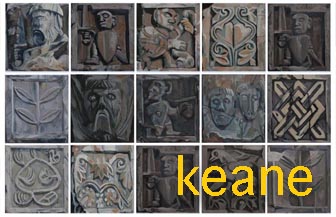On either side of the piazza Garibaldi there are two passageways which lead down towards the Via della Fontana. Facing onto the piazza itself is one of the most beautiful of all the buildings in the historic town centre, the Palazzo Balduini, built by the Barghigiano, Balduino Balduini in the second half of the 16th Century.
Balduini was the chief physician for Cardinal Del Monte who later became Pope Julius III, and who in 1554, nominated Balduini as Bishop of Aversa. It should be noted that this Balduini is not the same as the one mentioned elsewhere in this guide.
Unfortunately this beautiful palazzo was heavily bombed during the last war and only its outer walls remained standing, but the imprint of the Medici can still be seen in the stone Medici crest which is attached to the facade of the building. On the corner of the building there is a crest, also in stone, of Bishop Balduino.
Next to this palazzo is the property of the Sisters of the Order of St. Joseph (Giuseppine), who used to run a nursery school there (article with many images of the Nuns [here] , and beyond this the [Museum of Memory which grew out of the ruins of buildings destroyed during the last war when Barga was for many months on the front of the Gothic Line.
Next to these buildings is the Via della Rota, which first deviates via a flight of steps up to the piazza and church of the Santissima Crocifisso, and then connects to Via della Speranza.
The Via della Rota is so-named because there used to be a convent on this street, with a structure at the entrance which turned on a wheel where newborn infants were left, because the families was so poor they could not look after them, or because they were not acknowledged by the family.
Since the first half of the 14th century, Barga Castle has represented the oldest most northerly outpost of the Florentine. This close relationship with Florence is widely seen by the strong influence that the city exerted on Barghigiano buildings.
In addition to a direct drive through which the “capital” promoted public construction sites in the mid 16th century, it was met with considerable interest by private individuals who went ahead with building their own homes following the tastes that had matured in Florence beginning with the 15th century
experiences of Leon Battista Alberti.
This is how the most important Barga families acquired homes that recall the prestigious Florentine palaces in terms of the organisation of their interiors and the layout of the external facades.
Modernisation of the town walls got underway in 1526 and the building work of the first buildings of clear Florentine inspiration began halfway through the century.
Palazzo Balduini was the first, so loyal to the Mannerist modules to make you think that architects from Florence were directly involved, characterised by kneeling windows similar to those in the Florentine Palazzo Grifoni, designed by Ammannati
Ai lati della piazza Garibaldi si trovano due passaggi che scendono verso la Via della Fontana. Di fronte alla piazza stessa si erge uno degli edifici più belli di tutto il centro storico, il Palazzo Balduini, costruito dal barghigiano Balduino Balduini nella seconda metà del XVI secolo.
Balduini fu il medico personale del cardinale Del Monte, che in seguito divenne Papa Giulio III, e che nel 1554 lo nominò Vescovo di Aversa. Va notato che questo Balduini non è lo stesso menzionato altrove in questa guida.
Purtroppo, questo splendido palazzo fu pesantemente bombardato durante l’ultima guerra e ne rimasero in piedi solo le mura esterne, ma l’impronta dei Medici è ancora visibile nello stemma mediceo in pietra posto sulla facciata dell’edificio. Sull’angolo del palazzo si trova anche uno stemma, sempre in pietra, di Monsignor Balduino.
Accanto a questo palazzo si trova la proprietà delle Suore dell’Ordine di San Giuseppe (Giuseppine), che un tempo gestivano lì una scuola materna (articolo con molte immagini delle suore qui). Oltre a questo, vi è il Museo della Memoria, nato dalle rovine degli edifici distrutti durante l’ultima guerra, quando Barga si trovava per molti mesi sulla linea del fronte della Linea Gotica.
Accanto a questi edifici si trova la Via della Rota, che prima devia attraverso una scalinata fino alla piazza e alla chiesa del Santissimo Crocifisso, per poi collegarsi con la Via della Speranza.
La Via della Rota deve il suo nome alla presenza, in passato, di un convento con una struttura all’ingresso che ruotava su una ruota, dove venivano lasciati i neonati che le famiglie, a causa della povertà, non potevano mantenere o che non venivano riconosciuti dalla famiglia.
Sin dalla prima metà del XIV secolo, il Castello di Barga ha rappresentato l’avamposto più settentrionale e antico della Repubblica Fiorentina. Questo stretto rapporto con Firenze è evidente nella forte influenza che la città ha esercitato sugli edifici barghigiani.
Oltre a una diretta iniziativa pubblica con cui la “capitale” promosse cantieri edili a partire dalla metà del XVI secolo, vi fu anche un notevole interesse da parte di privati, che costruirono le proprie abitazioni seguendo i gusti maturati a Firenze a partire dalle esperienze del XV secolo di Leon Battista Alberti.
Fu così che le famiglie più importanti di Barga acquisirono dimore che, nell’organizzazione degli interni e nella disposizione delle facciate esterne, ricordano i prestigiosi palazzi fiorentini.
La modernizzazione delle mura cittadine iniziò nel 1526 e, a metà secolo, ebbero inizio i primi edifici di chiara ispirazione fiorentina.
Palazzo Balduini fu il primo, così fedele ai moduli manieristi da far pensare al coinvolgimento diretto di architetti fiorentini, caratterizzato da finestre inginocchiate simili a quelle del Palazzo Grifoni di Firenze, progettato da Ammannati.









